Criminal Law: Offences Against the Person - Case Study and Analysis
VerifiedAdded on 2020/07/23
|17
|5041
|37
Report
AI Summary
This report provides a detailed analysis of criminal law, specifically focusing on offences against the person and property. It examines several case studies, including R v Katie, R v Carson, and R v Jake, exploring legal concepts such as actus reus, mens rea, involuntary manslaughter, and voluntary manslaughter. The report delves into potential defenses and the application of relevant case law, such as R v Woollin, R v Nedrick, and R v Duffy. It also addresses scenarios involving assault, battery, and property crimes, offering insights into the legal principles and outcomes. The report concludes with an overview of the legal principles and outcomes related to the cases discussed, including potential defenses and the application of relevant case law.

Criminal Law
Paraphrase This Document
Need a fresh take? Get an instant paraphrase of this document with our AI Paraphraser
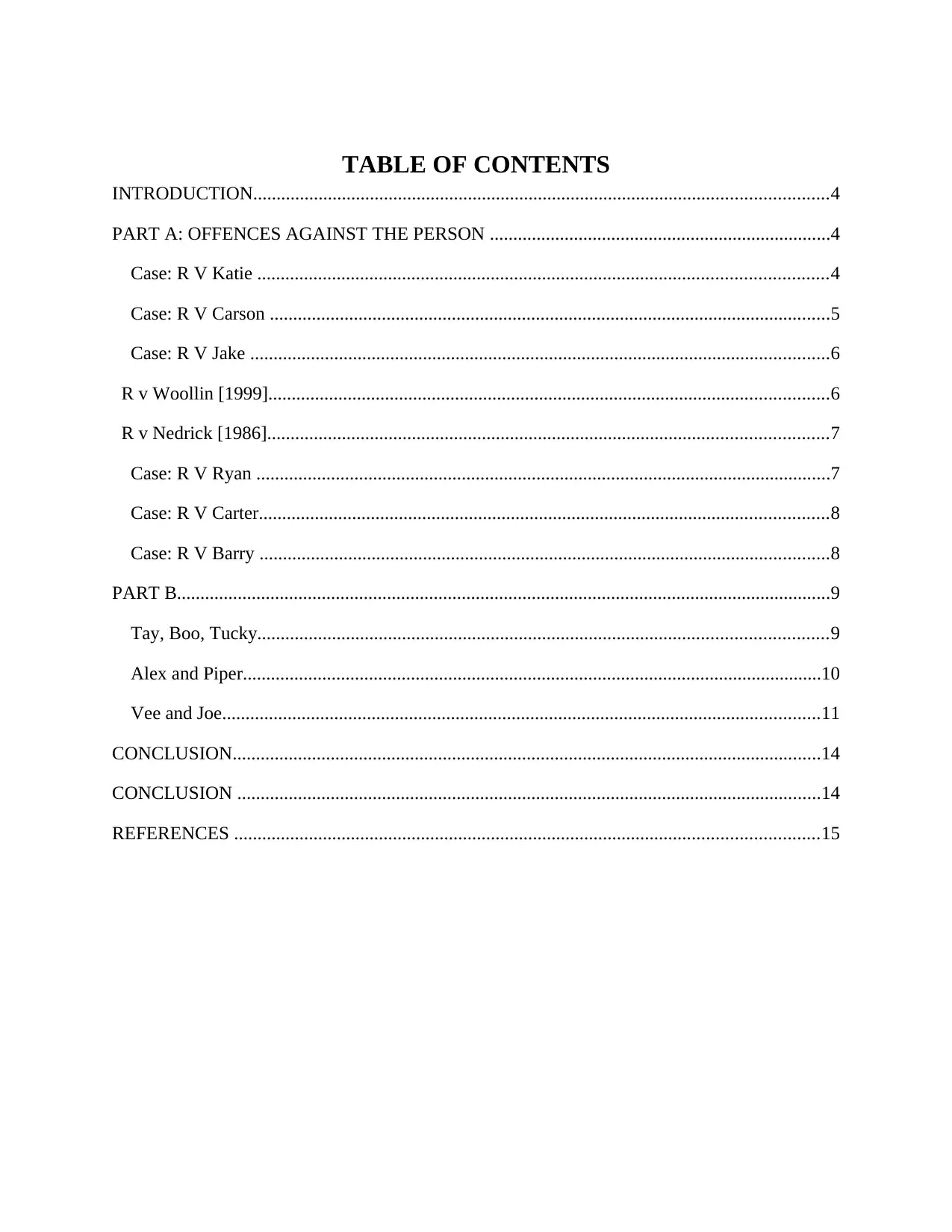
TABLE OF CONTENTS
INTRODUCTION...........................................................................................................................4
PART A: OFFENCES AGAINST THE PERSON .........................................................................4
Case: R V Katie ..........................................................................................................................4
Case: R V Carson ........................................................................................................................5
Case: R V Jake ............................................................................................................................6
R v Woollin [1999]........................................................................................................................6
R v Nedrick [1986]........................................................................................................................7
Case: R V Ryan ...........................................................................................................................7
Case: R V Carter..........................................................................................................................8
Case: R V Barry ..........................................................................................................................8
PART B............................................................................................................................................9
Tay, Boo, Tucky..........................................................................................................................9
Alex and Piper............................................................................................................................10
Vee and Joe................................................................................................................................11
CONCLUSION..............................................................................................................................14
CONCLUSION .............................................................................................................................14
REFERENCES .............................................................................................................................15
INTRODUCTION...........................................................................................................................4
PART A: OFFENCES AGAINST THE PERSON .........................................................................4
Case: R V Katie ..........................................................................................................................4
Case: R V Carson ........................................................................................................................5
Case: R V Jake ............................................................................................................................6
R v Woollin [1999]........................................................................................................................6
R v Nedrick [1986]........................................................................................................................7
Case: R V Ryan ...........................................................................................................................7
Case: R V Carter..........................................................................................................................8
Case: R V Barry ..........................................................................................................................8
PART B............................................................................................................................................9
Tay, Boo, Tucky..........................................................................................................................9
Alex and Piper............................................................................................................................10
Vee and Joe................................................................................................................................11
CONCLUSION..............................................................................................................................14
CONCLUSION .............................................................................................................................14
REFERENCES .............................................................................................................................15
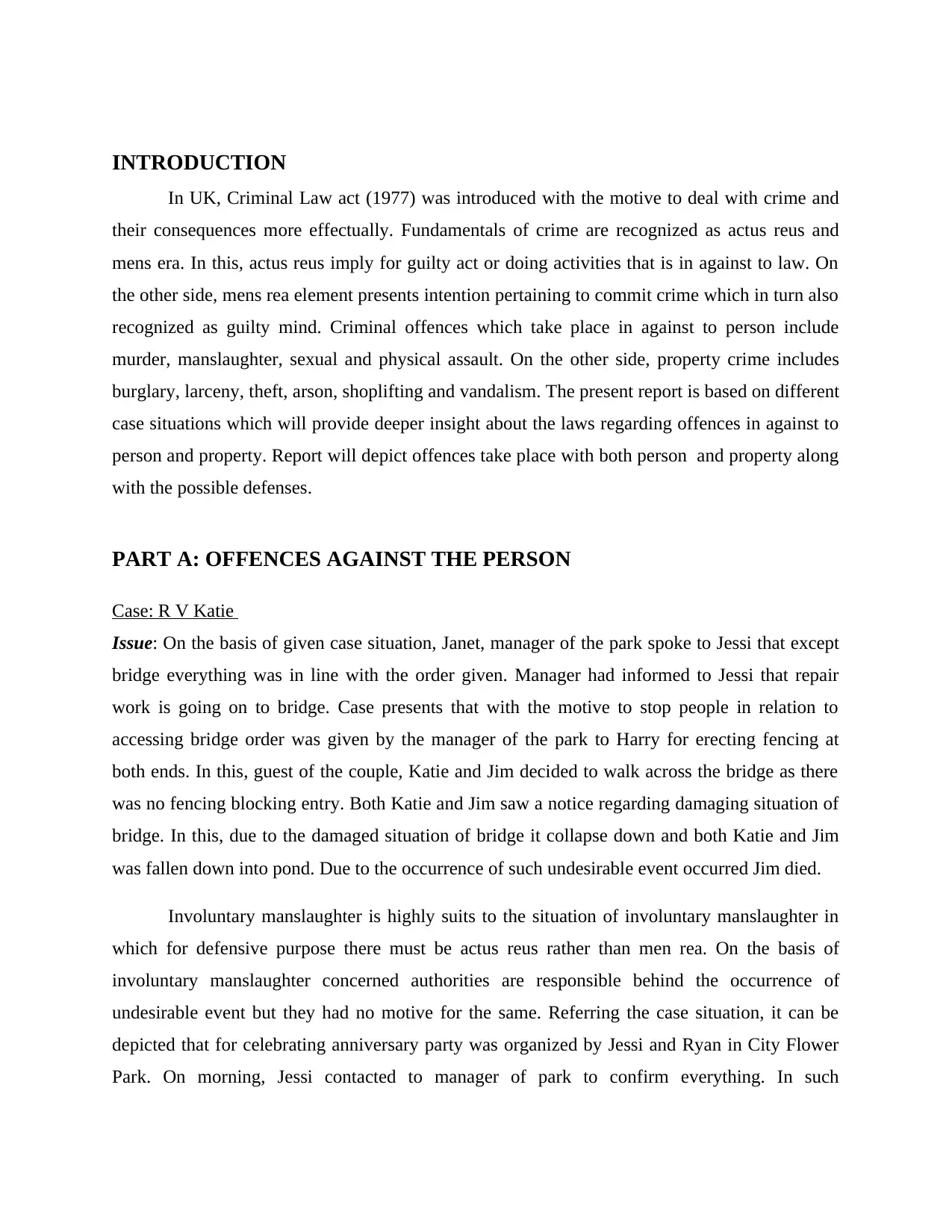
INTRODUCTION
In UK, Criminal Law act (1977) was introduced with the motive to deal with crime and
their consequences more effectually. Fundamentals of crime are recognized as actus reus and
mens era. In this, actus reus imply for guilty act or doing activities that is in against to law. On
the other side, mens rea element presents intention pertaining to commit crime which in turn also
recognized as guilty mind. Criminal offences which take place in against to person include
murder, manslaughter, sexual and physical assault. On the other side, property crime includes
burglary, larceny, theft, arson, shoplifting and vandalism. The present report is based on different
case situations which will provide deeper insight about the laws regarding offences in against to
person and property. Report will depict offences take place with both person and property along
with the possible defenses.
PART A: OFFENCES AGAINST THE PERSON
Case: R V Katie
Issue: On the basis of given case situation, Janet, manager of the park spoke to Jessi that except
bridge everything was in line with the order given. Manager had informed to Jessi that repair
work is going on to bridge. Case presents that with the motive to stop people in relation to
accessing bridge order was given by the manager of the park to Harry for erecting fencing at
both ends. In this, guest of the couple, Katie and Jim decided to walk across the bridge as there
was no fencing blocking entry. Both Katie and Jim saw a notice regarding damaging situation of
bridge. In this, due to the damaged situation of bridge it collapse down and both Katie and Jim
was fallen down into pond. Due to the occurrence of such undesirable event occurred Jim died.
Involuntary manslaughter is highly suits to the situation of involuntary manslaughter in
which for defensive purpose there must be actus reus rather than men rea. On the basis of
involuntary manslaughter concerned authorities are responsible behind the occurrence of
undesirable event but they had no motive for the same. Referring the case situation, it can be
depicted that for celebrating anniversary party was organized by Jessi and Ryan in City Flower
Park. On morning, Jessi contacted to manager of park to confirm everything. In such
In UK, Criminal Law act (1977) was introduced with the motive to deal with crime and
their consequences more effectually. Fundamentals of crime are recognized as actus reus and
mens era. In this, actus reus imply for guilty act or doing activities that is in against to law. On
the other side, mens rea element presents intention pertaining to commit crime which in turn also
recognized as guilty mind. Criminal offences which take place in against to person include
murder, manslaughter, sexual and physical assault. On the other side, property crime includes
burglary, larceny, theft, arson, shoplifting and vandalism. The present report is based on different
case situations which will provide deeper insight about the laws regarding offences in against to
person and property. Report will depict offences take place with both person and property along
with the possible defenses.
PART A: OFFENCES AGAINST THE PERSON
Case: R V Katie
Issue: On the basis of given case situation, Janet, manager of the park spoke to Jessi that except
bridge everything was in line with the order given. Manager had informed to Jessi that repair
work is going on to bridge. Case presents that with the motive to stop people in relation to
accessing bridge order was given by the manager of the park to Harry for erecting fencing at
both ends. In this, guest of the couple, Katie and Jim decided to walk across the bridge as there
was no fencing blocking entry. Both Katie and Jim saw a notice regarding damaging situation of
bridge. In this, due to the damaged situation of bridge it collapse down and both Katie and Jim
was fallen down into pond. Due to the occurrence of such undesirable event occurred Jim died.
Involuntary manslaughter is highly suits to the situation of involuntary manslaughter in
which for defensive purpose there must be actus reus rather than men rea. On the basis of
involuntary manslaughter concerned authorities are responsible behind the occurrence of
undesirable event but they had no motive for the same. Referring the case situation, it can be
depicted that for celebrating anniversary party was organized by Jessi and Ryan in City Flower
Park. On morning, Jessi contacted to manager of park to confirm everything. In such
⊘ This is a preview!⊘
Do you want full access?
Subscribe today to unlock all pages.

Trusted by 1+ million students worldwide
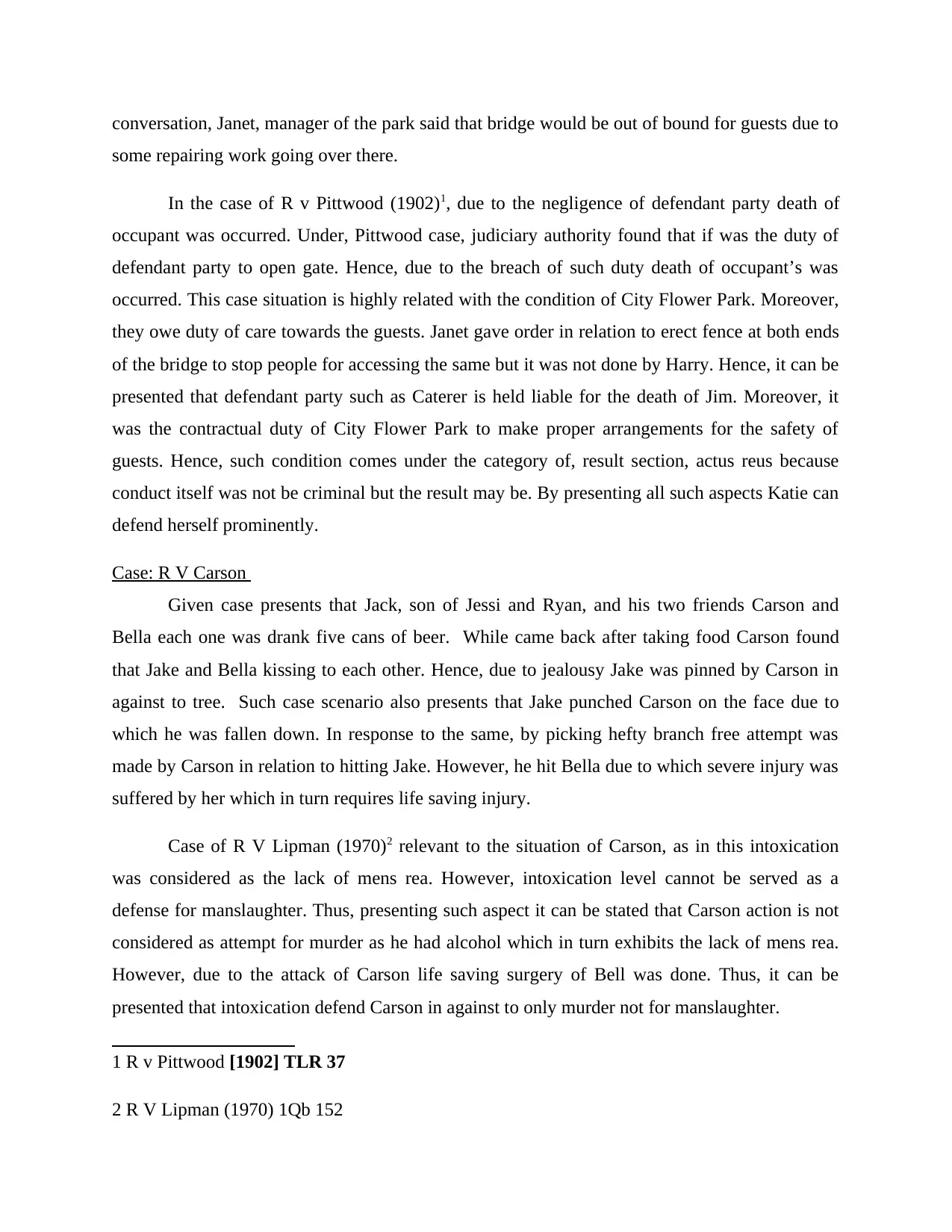
conversation, Janet, manager of the park said that bridge would be out of bound for guests due to
some repairing work going over there.
In the case of R v Pittwood (1902)1, due to the negligence of defendant party death of
occupant was occurred. Under, Pittwood case, judiciary authority found that if was the duty of
defendant party to open gate. Hence, due to the breach of such duty death of occupant’s was
occurred. This case situation is highly related with the condition of City Flower Park. Moreover,
they owe duty of care towards the guests. Janet gave order in relation to erect fence at both ends
of the bridge to stop people for accessing the same but it was not done by Harry. Hence, it can be
presented that defendant party such as Caterer is held liable for the death of Jim. Moreover, it
was the contractual duty of City Flower Park to make proper arrangements for the safety of
guests. Hence, such condition comes under the category of, result section, actus reus because
conduct itself was not be criminal but the result may be. By presenting all such aspects Katie can
defend herself prominently.
Case: R V Carson
Given case presents that Jack, son of Jessi and Ryan, and his two friends Carson and
Bella each one was drank five cans of beer. While came back after taking food Carson found
that Jake and Bella kissing to each other. Hence, due to jealousy Jake was pinned by Carson in
against to tree. Such case scenario also presents that Jake punched Carson on the face due to
which he was fallen down. In response to the same, by picking hefty branch free attempt was
made by Carson in relation to hitting Jake. However, he hit Bella due to which severe injury was
suffered by her which in turn requires life saving injury.
Case of R V Lipman (1970)2 relevant to the situation of Carson, as in this intoxication
was considered as the lack of mens rea. However, intoxication level cannot be served as a
defense for manslaughter. Thus, presenting such aspect it can be stated that Carson action is not
considered as attempt for murder as he had alcohol which in turn exhibits the lack of mens rea.
However, due to the attack of Carson life saving surgery of Bell was done. Thus, it can be
presented that intoxication defend Carson in against to only murder not for manslaughter.
1 R v Pittwood [1902] TLR 37
2 R V Lipman (1970) 1Qb 152
some repairing work going over there.
In the case of R v Pittwood (1902)1, due to the negligence of defendant party death of
occupant was occurred. Under, Pittwood case, judiciary authority found that if was the duty of
defendant party to open gate. Hence, due to the breach of such duty death of occupant’s was
occurred. This case situation is highly related with the condition of City Flower Park. Moreover,
they owe duty of care towards the guests. Janet gave order in relation to erect fence at both ends
of the bridge to stop people for accessing the same but it was not done by Harry. Hence, it can be
presented that defendant party such as Caterer is held liable for the death of Jim. Moreover, it
was the contractual duty of City Flower Park to make proper arrangements for the safety of
guests. Hence, such condition comes under the category of, result section, actus reus because
conduct itself was not be criminal but the result may be. By presenting all such aspects Katie can
defend herself prominently.
Case: R V Carson
Given case presents that Jack, son of Jessi and Ryan, and his two friends Carson and
Bella each one was drank five cans of beer. While came back after taking food Carson found
that Jake and Bella kissing to each other. Hence, due to jealousy Jake was pinned by Carson in
against to tree. Such case scenario also presents that Jake punched Carson on the face due to
which he was fallen down. In response to the same, by picking hefty branch free attempt was
made by Carson in relation to hitting Jake. However, he hit Bella due to which severe injury was
suffered by her which in turn requires life saving injury.
Case of R V Lipman (1970)2 relevant to the situation of Carson, as in this intoxication
was considered as the lack of mens rea. However, intoxication level cannot be served as a
defense for manslaughter. Thus, presenting such aspect it can be stated that Carson action is not
considered as attempt for murder as he had alcohol which in turn exhibits the lack of mens rea.
However, due to the attack of Carson life saving surgery of Bell was done. Thus, it can be
presented that intoxication defend Carson in against to only murder not for manslaughter.
1 R v Pittwood [1902] TLR 37
2 R V Lipman (1970) 1Qb 152
Paraphrase This Document
Need a fresh take? Get an instant paraphrase of this document with our AI Paraphraser
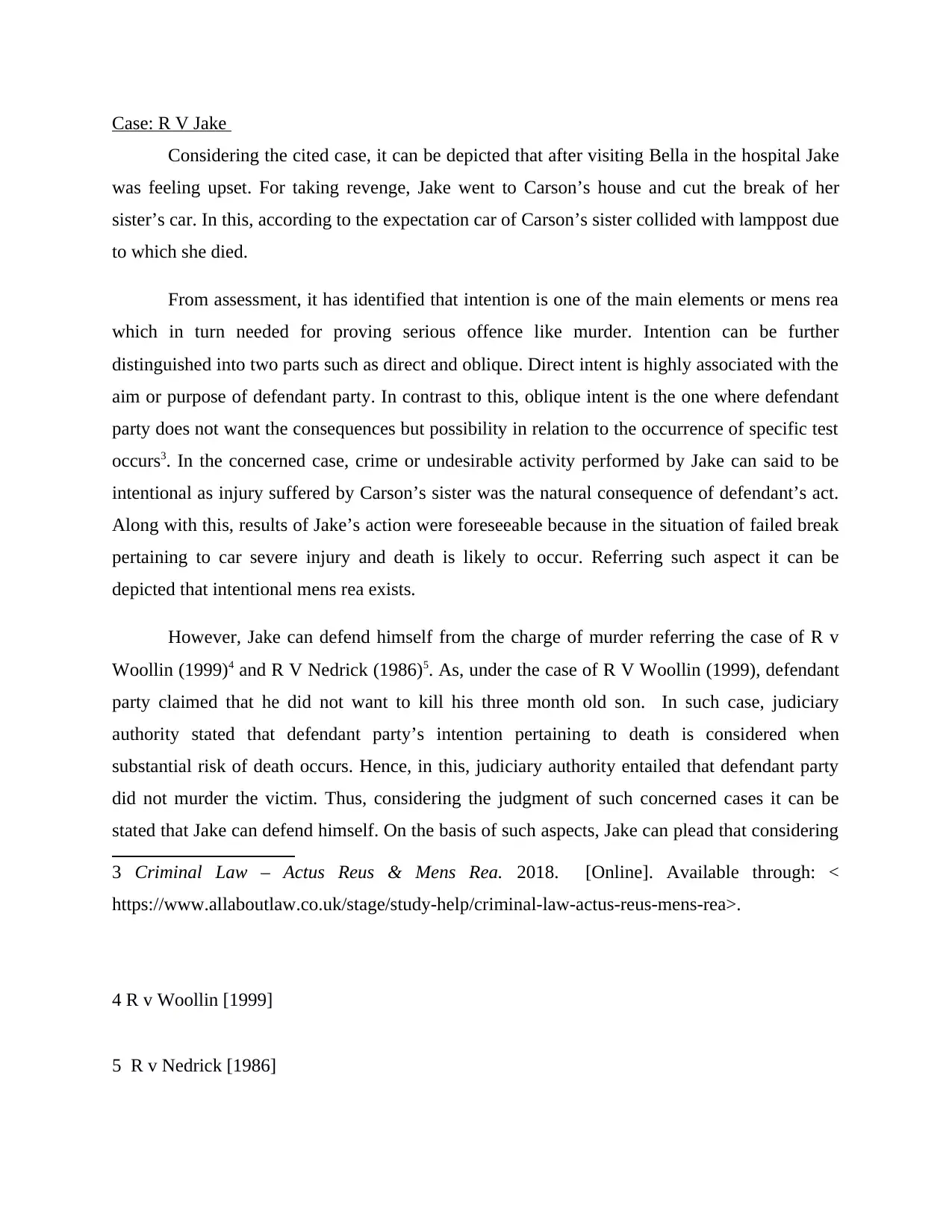
Case: R V Jake
Considering the cited case, it can be depicted that after visiting Bella in the hospital Jake
was feeling upset. For taking revenge, Jake went to Carson’s house and cut the break of her
sister’s car. In this, according to the expectation car of Carson’s sister collided with lamppost due
to which she died.
From assessment, it has identified that intention is one of the main elements or mens rea
which in turn needed for proving serious offence like murder. Intention can be further
distinguished into two parts such as direct and oblique. Direct intent is highly associated with the
aim or purpose of defendant party. In contrast to this, oblique intent is the one where defendant
party does not want the consequences but possibility in relation to the occurrence of specific test
occurs3. In the concerned case, crime or undesirable activity performed by Jake can said to be
intentional as injury suffered by Carson’s sister was the natural consequence of defendant’s act.
Along with this, results of Jake’s action were foreseeable because in the situation of failed break
pertaining to car severe injury and death is likely to occur. Referring such aspect it can be
depicted that intentional mens rea exists.
However, Jake can defend himself from the charge of murder referring the case of R v
Woollin (1999)4 and R V Nedrick (1986)5. As, under the case of R V Woollin (1999), defendant
party claimed that he did not want to kill his three month old son. In such case, judiciary
authority stated that defendant party’s intention pertaining to death is considered when
substantial risk of death occurs. Hence, in this, judiciary authority entailed that defendant party
did not murder the victim. Thus, considering the judgment of such concerned cases it can be
stated that Jake can defend himself. On the basis of such aspects, Jake can plead that considering
3 Criminal Law – Actus Reus & Mens Rea. 2018. [Online]. Available through: <
https://www.allaboutlaw.co.uk/stage/study-help/criminal-law-actus-reus-mens-rea>.
4 R v Woollin [1999]
5 R v Nedrick [1986]
Considering the cited case, it can be depicted that after visiting Bella in the hospital Jake
was feeling upset. For taking revenge, Jake went to Carson’s house and cut the break of her
sister’s car. In this, according to the expectation car of Carson’s sister collided with lamppost due
to which she died.
From assessment, it has identified that intention is one of the main elements or mens rea
which in turn needed for proving serious offence like murder. Intention can be further
distinguished into two parts such as direct and oblique. Direct intent is highly associated with the
aim or purpose of defendant party. In contrast to this, oblique intent is the one where defendant
party does not want the consequences but possibility in relation to the occurrence of specific test
occurs3. In the concerned case, crime or undesirable activity performed by Jake can said to be
intentional as injury suffered by Carson’s sister was the natural consequence of defendant’s act.
Along with this, results of Jake’s action were foreseeable because in the situation of failed break
pertaining to car severe injury and death is likely to occur. Referring such aspect it can be
depicted that intentional mens rea exists.
However, Jake can defend himself from the charge of murder referring the case of R v
Woollin (1999)4 and R V Nedrick (1986)5. As, under the case of R V Woollin (1999), defendant
party claimed that he did not want to kill his three month old son. In such case, judiciary
authority stated that defendant party’s intention pertaining to death is considered when
substantial risk of death occurs. Hence, in this, judiciary authority entailed that defendant party
did not murder the victim. Thus, considering the judgment of such concerned cases it can be
stated that Jake can defend himself. On the basis of such aspects, Jake can plead that considering
3 Criminal Law – Actus Reus & Mens Rea. 2018. [Online]. Available through: <
https://www.allaboutlaw.co.uk/stage/study-help/criminal-law-actus-reus-mens-rea>.
4 R v Woollin [1999]
5 R v Nedrick [1986]
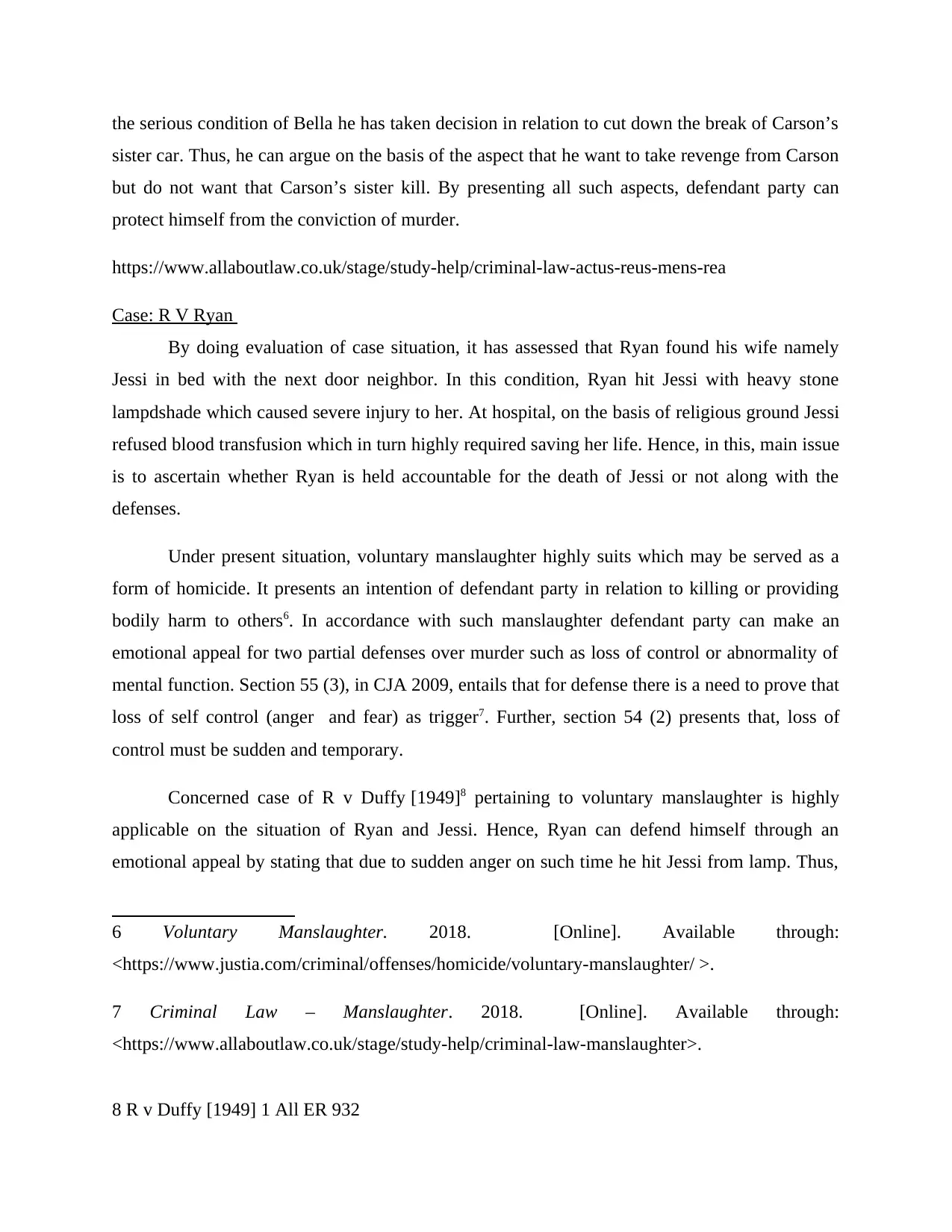
the serious condition of Bella he has taken decision in relation to cut down the break of Carson’s
sister car. Thus, he can argue on the basis of the aspect that he want to take revenge from Carson
but do not want that Carson’s sister kill. By presenting all such aspects, defendant party can
protect himself from the conviction of murder.
https://www.allaboutlaw.co.uk/stage/study-help/criminal-law-actus-reus-mens-rea
Case: R V Ryan
By doing evaluation of case situation, it has assessed that Ryan found his wife namely
Jessi in bed with the next door neighbor. In this condition, Ryan hit Jessi with heavy stone
lampdshade which caused severe injury to her. At hospital, on the basis of religious ground Jessi
refused blood transfusion which in turn highly required saving her life. Hence, in this, main issue
is to ascertain whether Ryan is held accountable for the death of Jessi or not along with the
defenses.
Under present situation, voluntary manslaughter highly suits which may be served as a
form of homicide. It presents an intention of defendant party in relation to killing or providing
bodily harm to others6. In accordance with such manslaughter defendant party can make an
emotional appeal for two partial defenses over murder such as loss of control or abnormality of
mental function. Section 55 (3), in CJA 2009, entails that for defense there is a need to prove that
loss of self control (anger and fear) as trigger7. Further, section 54 (2) presents that, loss of
control must be sudden and temporary.
Concerned case of R v Duffy [1949]8 pertaining to voluntary manslaughter is highly
applicable on the situation of Ryan and Jessi. Hence, Ryan can defend himself through an
emotional appeal by stating that due to sudden anger on such time he hit Jessi from lamp. Thus,
6 Voluntary Manslaughter. 2018. [Online]. Available through:
<https://www.justia.com/criminal/offenses/homicide/voluntary-manslaughter/ >.
7 Criminal Law – Manslaughter. 2018. [Online]. Available through:
<https://www.allaboutlaw.co.uk/stage/study-help/criminal-law-manslaughter>.
8 R v Duffy [1949] 1 All ER 932
sister car. Thus, he can argue on the basis of the aspect that he want to take revenge from Carson
but do not want that Carson’s sister kill. By presenting all such aspects, defendant party can
protect himself from the conviction of murder.
https://www.allaboutlaw.co.uk/stage/study-help/criminal-law-actus-reus-mens-rea
Case: R V Ryan
By doing evaluation of case situation, it has assessed that Ryan found his wife namely
Jessi in bed with the next door neighbor. In this condition, Ryan hit Jessi with heavy stone
lampdshade which caused severe injury to her. At hospital, on the basis of religious ground Jessi
refused blood transfusion which in turn highly required saving her life. Hence, in this, main issue
is to ascertain whether Ryan is held accountable for the death of Jessi or not along with the
defenses.
Under present situation, voluntary manslaughter highly suits which may be served as a
form of homicide. It presents an intention of defendant party in relation to killing or providing
bodily harm to others6. In accordance with such manslaughter defendant party can make an
emotional appeal for two partial defenses over murder such as loss of control or abnormality of
mental function. Section 55 (3), in CJA 2009, entails that for defense there is a need to prove that
loss of self control (anger and fear) as trigger7. Further, section 54 (2) presents that, loss of
control must be sudden and temporary.
Concerned case of R v Duffy [1949]8 pertaining to voluntary manslaughter is highly
applicable on the situation of Ryan and Jessi. Hence, Ryan can defend himself through an
emotional appeal by stating that due to sudden anger on such time he hit Jessi from lamp. Thus,
6 Voluntary Manslaughter. 2018. [Online]. Available through:
<https://www.justia.com/criminal/offenses/homicide/voluntary-manslaughter/ >.
7 Criminal Law – Manslaughter. 2018. [Online]. Available through:
<https://www.allaboutlaw.co.uk/stage/study-help/criminal-law-manslaughter>.
8 R v Duffy [1949] 1 All ER 932
⊘ This is a preview!⊘
Do you want full access?
Subscribe today to unlock all pages.

Trusted by 1+ million students worldwide
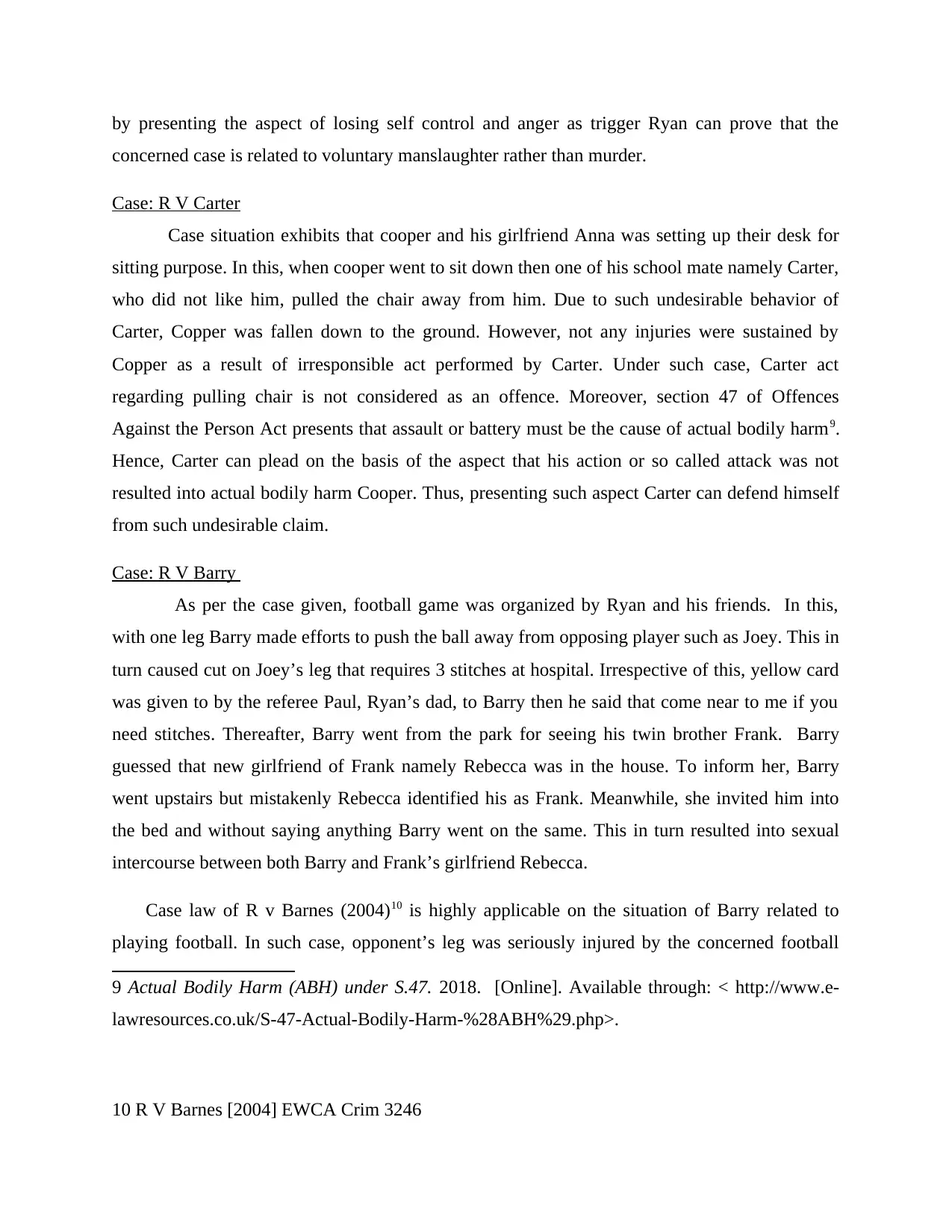
by presenting the aspect of losing self control and anger as trigger Ryan can prove that the
concerned case is related to voluntary manslaughter rather than murder.
Case: R V Carter
Case situation exhibits that cooper and his girlfriend Anna was setting up their desk for
sitting purpose. In this, when cooper went to sit down then one of his school mate namely Carter,
who did not like him, pulled the chair away from him. Due to such undesirable behavior of
Carter, Copper was fallen down to the ground. However, not any injuries were sustained by
Copper as a result of irresponsible act performed by Carter. Under such case, Carter act
regarding pulling chair is not considered as an offence. Moreover, section 47 of Offences
Against the Person Act presents that assault or battery must be the cause of actual bodily harm9.
Hence, Carter can plead on the basis of the aspect that his action or so called attack was not
resulted into actual bodily harm Cooper. Thus, presenting such aspect Carter can defend himself
from such undesirable claim.
Case: R V Barry
As per the case given, football game was organized by Ryan and his friends. In this,
with one leg Barry made efforts to push the ball away from opposing player such as Joey. This in
turn caused cut on Joey’s leg that requires 3 stitches at hospital. Irrespective of this, yellow card
was given to by the referee Paul, Ryan’s dad, to Barry then he said that come near to me if you
need stitches. Thereafter, Barry went from the park for seeing his twin brother Frank. Barry
guessed that new girlfriend of Frank namely Rebecca was in the house. To inform her, Barry
went upstairs but mistakenly Rebecca identified his as Frank. Meanwhile, she invited him into
the bed and without saying anything Barry went on the same. This in turn resulted into sexual
intercourse between both Barry and Frank’s girlfriend Rebecca.
Case law of R v Barnes (2004)10 is highly applicable on the situation of Barry related to
playing football. In such case, opponent’s leg was seriously injured by the concerned football
9 Actual Bodily Harm (ABH) under S.47. 2018. [Online]. Available through: < http://www.e-
lawresources.co.uk/S-47-Actual-Bodily-Harm-%28ABH%29.php>.
10 R V Barnes [2004] EWCA Crim 3246
concerned case is related to voluntary manslaughter rather than murder.
Case: R V Carter
Case situation exhibits that cooper and his girlfriend Anna was setting up their desk for
sitting purpose. In this, when cooper went to sit down then one of his school mate namely Carter,
who did not like him, pulled the chair away from him. Due to such undesirable behavior of
Carter, Copper was fallen down to the ground. However, not any injuries were sustained by
Copper as a result of irresponsible act performed by Carter. Under such case, Carter act
regarding pulling chair is not considered as an offence. Moreover, section 47 of Offences
Against the Person Act presents that assault or battery must be the cause of actual bodily harm9.
Hence, Carter can plead on the basis of the aspect that his action or so called attack was not
resulted into actual bodily harm Cooper. Thus, presenting such aspect Carter can defend himself
from such undesirable claim.
Case: R V Barry
As per the case given, football game was organized by Ryan and his friends. In this,
with one leg Barry made efforts to push the ball away from opposing player such as Joey. This in
turn caused cut on Joey’s leg that requires 3 stitches at hospital. Irrespective of this, yellow card
was given to by the referee Paul, Ryan’s dad, to Barry then he said that come near to me if you
need stitches. Thereafter, Barry went from the park for seeing his twin brother Frank. Barry
guessed that new girlfriend of Frank namely Rebecca was in the house. To inform her, Barry
went upstairs but mistakenly Rebecca identified his as Frank. Meanwhile, she invited him into
the bed and without saying anything Barry went on the same. This in turn resulted into sexual
intercourse between both Barry and Frank’s girlfriend Rebecca.
Case law of R v Barnes (2004)10 is highly applicable on the situation of Barry related to
playing football. In such case, opponent’s leg was seriously injured by the concerned football
9 Actual Bodily Harm (ABH) under S.47. 2018. [Online]. Available through: < http://www.e-
lawresources.co.uk/S-47-Actual-Bodily-Harm-%28ABH%29.php>.
10 R V Barnes [2004] EWCA Crim 3246
Paraphrase This Document
Need a fresh take? Get an instant paraphrase of this document with our AI Paraphraser
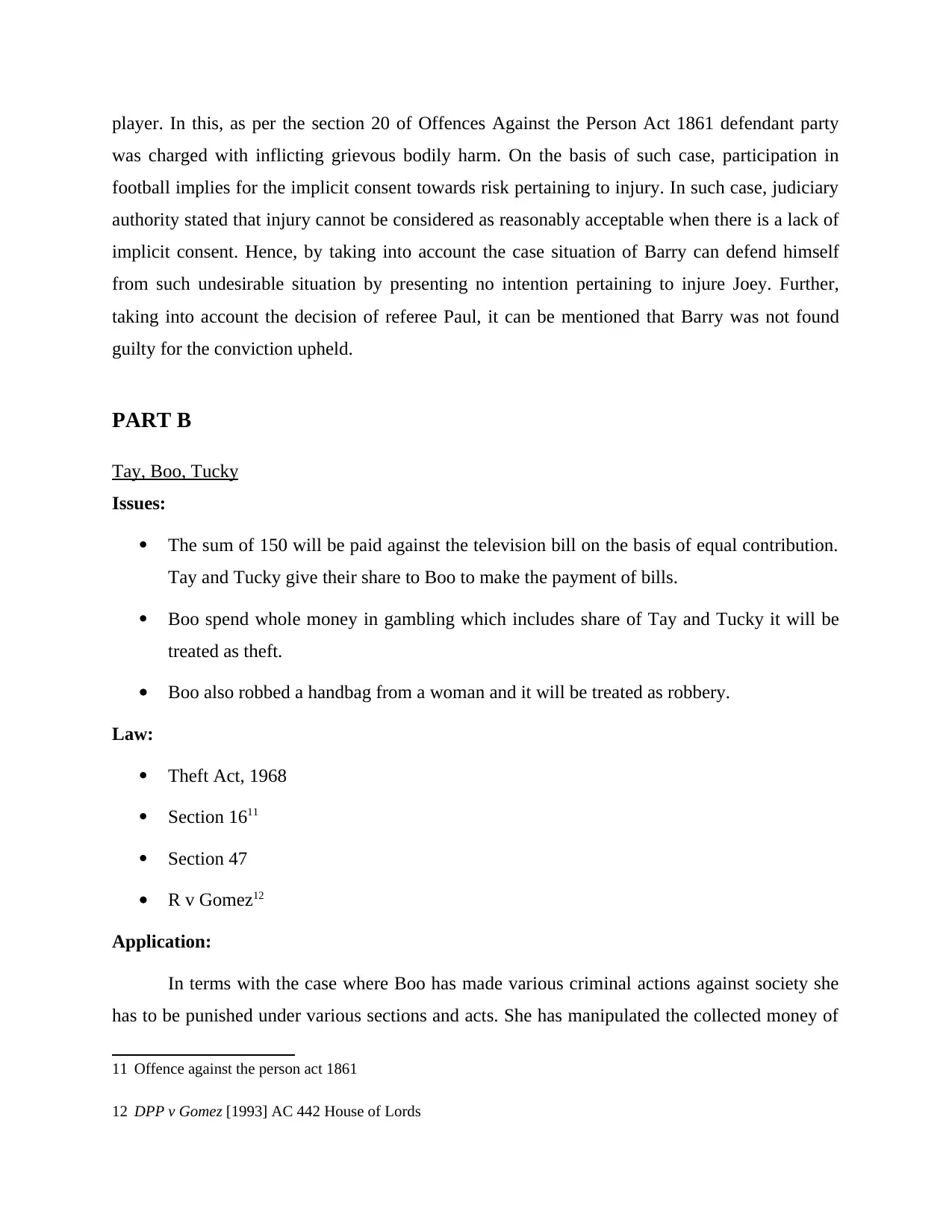
player. In this, as per the section 20 of Offences Against the Person Act 1861 defendant party
was charged with inflicting grievous bodily harm. On the basis of such case, participation in
football implies for the implicit consent towards risk pertaining to injury. In such case, judiciary
authority stated that injury cannot be considered as reasonably acceptable when there is a lack of
implicit consent. Hence, by taking into account the case situation of Barry can defend himself
from such undesirable situation by presenting no intention pertaining to injure Joey. Further,
taking into account the decision of referee Paul, it can be mentioned that Barry was not found
guilty for the conviction upheld.
PART B
Tay, Boo, Tucky
Issues:
The sum of 150 will be paid against the television bill on the basis of equal contribution.
Tay and Tucky give their share to Boo to make the payment of bills.
Boo spend whole money in gambling which includes share of Tay and Tucky it will be
treated as theft.
Boo also robbed a handbag from a woman and it will be treated as robbery.
Law:
Theft Act, 1968
Section 1611
Section 47
R v Gomez12
Application:
In terms with the case where Boo has made various criminal actions against society she
has to be punished under various sections and acts. She has manipulated the collected money of
11 Offence against the person act 1861
12 DPP v Gomez [1993] AC 442 House of Lords
was charged with inflicting grievous bodily harm. On the basis of such case, participation in
football implies for the implicit consent towards risk pertaining to injury. In such case, judiciary
authority stated that injury cannot be considered as reasonably acceptable when there is a lack of
implicit consent. Hence, by taking into account the case situation of Barry can defend himself
from such undesirable situation by presenting no intention pertaining to injure Joey. Further,
taking into account the decision of referee Paul, it can be mentioned that Barry was not found
guilty for the conviction upheld.
PART B
Tay, Boo, Tucky
Issues:
The sum of 150 will be paid against the television bill on the basis of equal contribution.
Tay and Tucky give their share to Boo to make the payment of bills.
Boo spend whole money in gambling which includes share of Tay and Tucky it will be
treated as theft.
Boo also robbed a handbag from a woman and it will be treated as robbery.
Law:
Theft Act, 1968
Section 1611
Section 47
R v Gomez12
Application:
In terms with the case where Boo has made various criminal actions against society she
has to be punished under various sections and acts. She has manipulated the collected money of
11 Offence against the person act 1861
12 DPP v Gomez [1993] AC 442 House of Lords
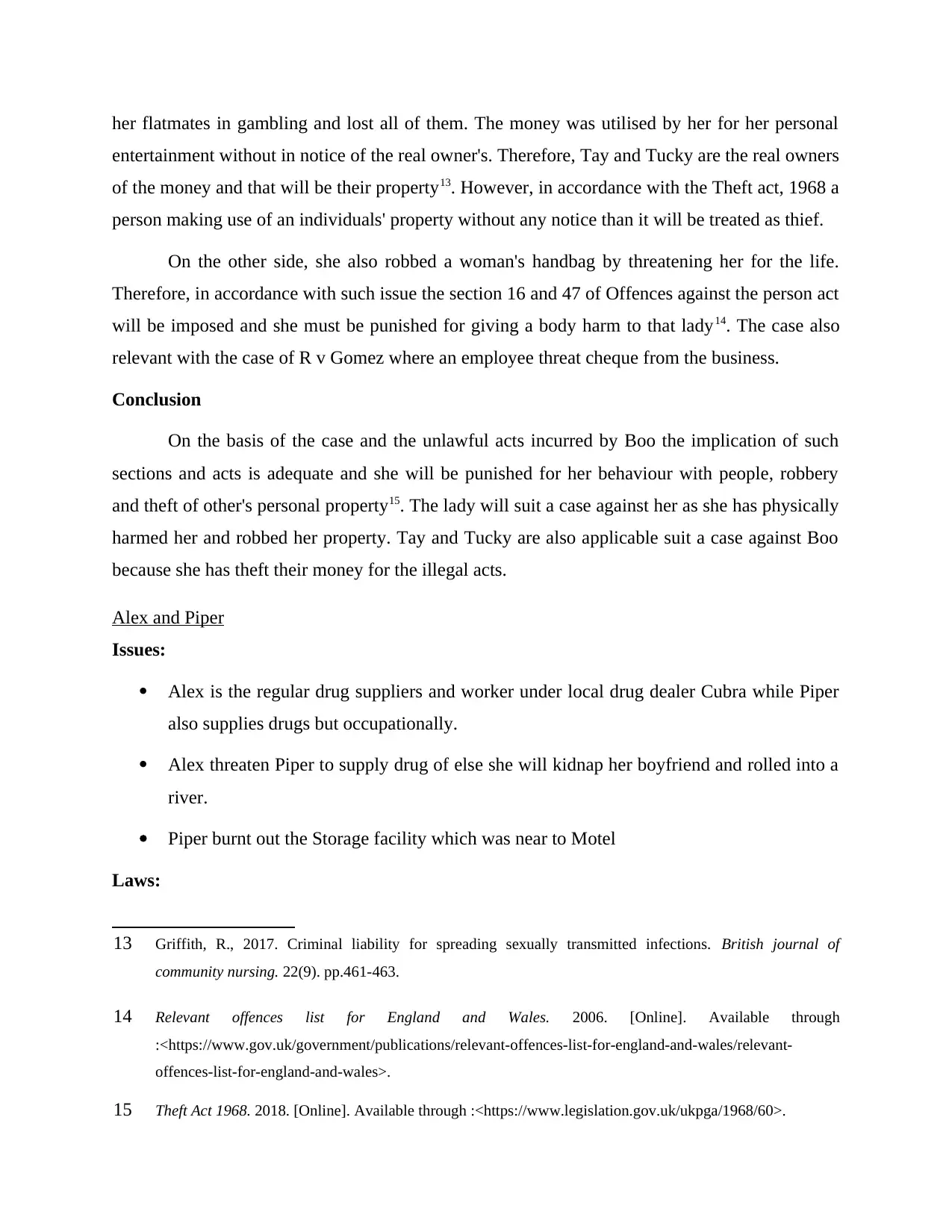
her flatmates in gambling and lost all of them. The money was utilised by her for her personal
entertainment without in notice of the real owner's. Therefore, Tay and Tucky are the real owners
of the money and that will be their property13. However, in accordance with the Theft act, 1968 a
person making use of an individuals' property without any notice than it will be treated as thief.
On the other side, she also robbed a woman's handbag by threatening her for the life.
Therefore, in accordance with such issue the section 16 and 47 of Offences against the person act
will be imposed and she must be punished for giving a body harm to that lady14. The case also
relevant with the case of R v Gomez where an employee threat cheque from the business.
Conclusion
On the basis of the case and the unlawful acts incurred by Boo the implication of such
sections and acts is adequate and she will be punished for her behaviour with people, robbery
and theft of other's personal property15. The lady will suit a case against her as she has physically
harmed her and robbed her property. Tay and Tucky are also applicable suit a case against Boo
because she has theft their money for the illegal acts.
Alex and Piper
Issues:
Alex is the regular drug suppliers and worker under local drug dealer Cubra while Piper
also supplies drugs but occupationally.
Alex threaten Piper to supply drug of else she will kidnap her boyfriend and rolled into a
river.
Piper burnt out the Storage facility which was near to Motel
Laws:
13 Griffith, R., 2017. Criminal liability for spreading sexually transmitted infections. British journal of
community nursing. 22(9). pp.461-463.
14 Relevant offences list for England and Wales. 2006. [Online]. Available through
:<https://www.gov.uk/government/publications/relevant-offences-list-for-england-and-wales/relevant-
offences-list-for-england-and-wales>.
15 Theft Act 1968. 2018. [Online]. Available through :<https://www.legislation.gov.uk/ukpga/1968/60>.
entertainment without in notice of the real owner's. Therefore, Tay and Tucky are the real owners
of the money and that will be their property13. However, in accordance with the Theft act, 1968 a
person making use of an individuals' property without any notice than it will be treated as thief.
On the other side, she also robbed a woman's handbag by threatening her for the life.
Therefore, in accordance with such issue the section 16 and 47 of Offences against the person act
will be imposed and she must be punished for giving a body harm to that lady14. The case also
relevant with the case of R v Gomez where an employee threat cheque from the business.
Conclusion
On the basis of the case and the unlawful acts incurred by Boo the implication of such
sections and acts is adequate and she will be punished for her behaviour with people, robbery
and theft of other's personal property15. The lady will suit a case against her as she has physically
harmed her and robbed her property. Tay and Tucky are also applicable suit a case against Boo
because she has theft their money for the illegal acts.
Alex and Piper
Issues:
Alex is the regular drug suppliers and worker under local drug dealer Cubra while Piper
also supplies drugs but occupationally.
Alex threaten Piper to supply drug of else she will kidnap her boyfriend and rolled into a
river.
Piper burnt out the Storage facility which was near to Motel
Laws:
13 Griffith, R., 2017. Criminal liability for spreading sexually transmitted infections. British journal of
community nursing. 22(9). pp.461-463.
14 Relevant offences list for England and Wales. 2006. [Online]. Available through
:<https://www.gov.uk/government/publications/relevant-offences-list-for-england-and-wales/relevant-
offences-list-for-england-and-wales>.
15 Theft Act 1968. 2018. [Online]. Available through :<https://www.legislation.gov.uk/ukpga/1968/60>.
⊘ This is a preview!⊘
Do you want full access?
Subscribe today to unlock all pages.

Trusted by 1+ million students worldwide
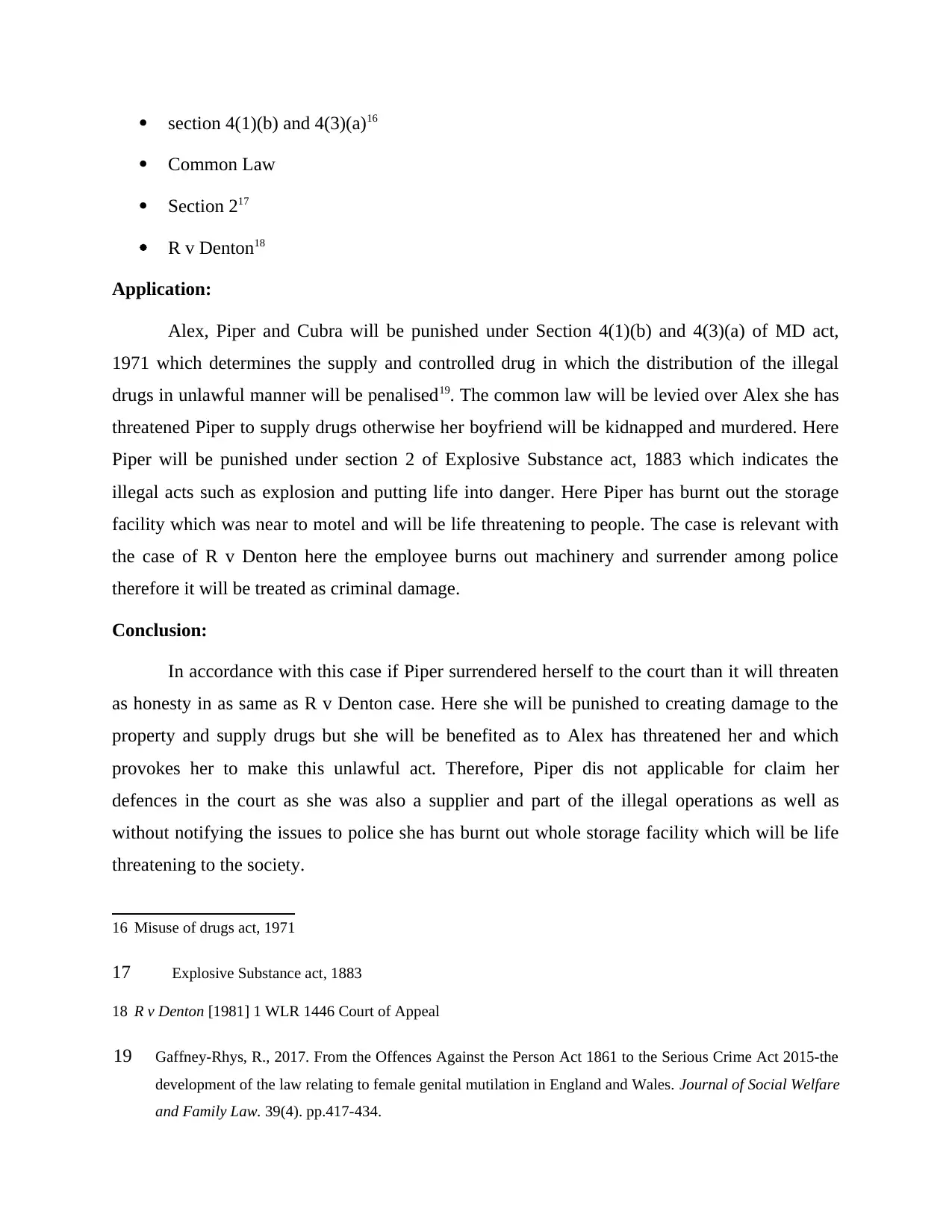
section 4(1)(b) and 4(3)(a)16
Common Law
Section 217
R v Denton18
Application:
Alex, Piper and Cubra will be punished under Section 4(1)(b) and 4(3)(a) of MD act,
1971 which determines the supply and controlled drug in which the distribution of the illegal
drugs in unlawful manner will be penalised19. The common law will be levied over Alex she has
threatened Piper to supply drugs otherwise her boyfriend will be kidnapped and murdered. Here
Piper will be punished under section 2 of Explosive Substance act, 1883 which indicates the
illegal acts such as explosion and putting life into danger. Here Piper has burnt out the storage
facility which was near to motel and will be life threatening to people. The case is relevant with
the case of R v Denton here the employee burns out machinery and surrender among police
therefore it will be treated as criminal damage.
Conclusion:
In accordance with this case if Piper surrendered herself to the court than it will threaten
as honesty in as same as R v Denton case. Here she will be punished to creating damage to the
property and supply drugs but she will be benefited as to Alex has threatened her and which
provokes her to make this unlawful act. Therefore, Piper dis not applicable for claim her
defences in the court as she was also a supplier and part of the illegal operations as well as
without notifying the issues to police she has burnt out whole storage facility which will be life
threatening to the society.
16 Misuse of drugs act, 1971
17 Explosive Substance act, 1883
18 R v Denton [1981] 1 WLR 1446 Court of Appeal
19 Gaffney-Rhys, R., 2017. From the Offences Against the Person Act 1861 to the Serious Crime Act 2015-the
development of the law relating to female genital mutilation in England and Wales. Journal of Social Welfare
and Family Law. 39(4). pp.417-434.
Common Law
Section 217
R v Denton18
Application:
Alex, Piper and Cubra will be punished under Section 4(1)(b) and 4(3)(a) of MD act,
1971 which determines the supply and controlled drug in which the distribution of the illegal
drugs in unlawful manner will be penalised19. The common law will be levied over Alex she has
threatened Piper to supply drugs otherwise her boyfriend will be kidnapped and murdered. Here
Piper will be punished under section 2 of Explosive Substance act, 1883 which indicates the
illegal acts such as explosion and putting life into danger. Here Piper has burnt out the storage
facility which was near to motel and will be life threatening to people. The case is relevant with
the case of R v Denton here the employee burns out machinery and surrender among police
therefore it will be treated as criminal damage.
Conclusion:
In accordance with this case if Piper surrendered herself to the court than it will threaten
as honesty in as same as R v Denton case. Here she will be punished to creating damage to the
property and supply drugs but she will be benefited as to Alex has threatened her and which
provokes her to make this unlawful act. Therefore, Piper dis not applicable for claim her
defences in the court as she was also a supplier and part of the illegal operations as well as
without notifying the issues to police she has burnt out whole storage facility which will be life
threatening to the society.
16 Misuse of drugs act, 1971
17 Explosive Substance act, 1883
18 R v Denton [1981] 1 WLR 1446 Court of Appeal
19 Gaffney-Rhys, R., 2017. From the Offences Against the Person Act 1861 to the Serious Crime Act 2015-the
development of the law relating to female genital mutilation in England and Wales. Journal of Social Welfare
and Family Law. 39(4). pp.417-434.
Paraphrase This Document
Need a fresh take? Get an instant paraphrase of this document with our AI Paraphraser
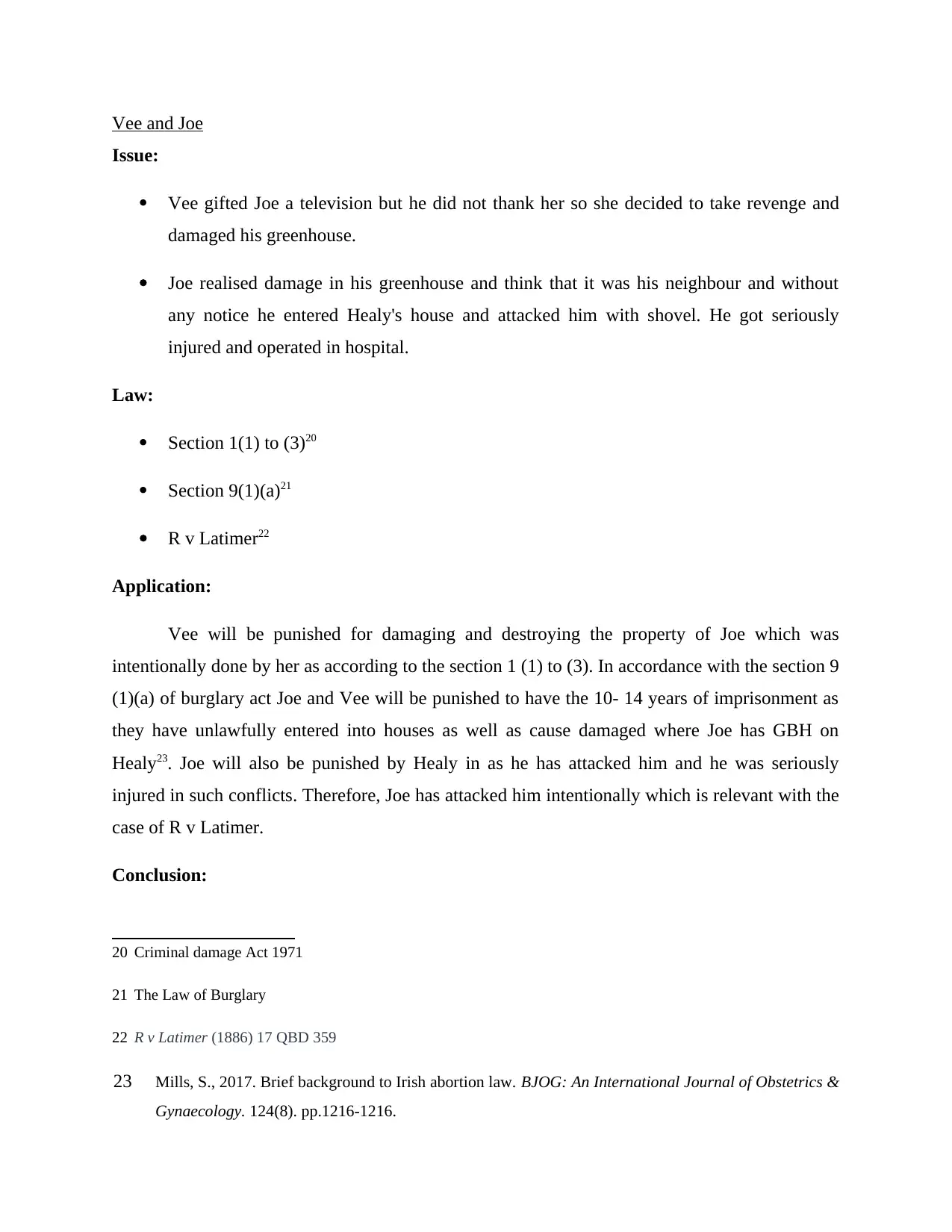
Vee and Joe
Issue:
Vee gifted Joe a television but he did not thank her so she decided to take revenge and
damaged his greenhouse.
Joe realised damage in his greenhouse and think that it was his neighbour and without
any notice he entered Healy's house and attacked him with shovel. He got seriously
injured and operated in hospital.
Law:
Section 1(1) to (3)20
Section 9(1)(a)21
R v Latimer22
Application:
Vee will be punished for damaging and destroying the property of Joe which was
intentionally done by her as according to the section 1 (1) to (3). In accordance with the section 9
(1)(a) of burglary act Joe and Vee will be punished to have the 10- 14 years of imprisonment as
they have unlawfully entered into houses as well as cause damaged where Joe has GBH on
Healy23. Joe will also be punished by Healy in as he has attacked him and he was seriously
injured in such conflicts. Therefore, Joe has attacked him intentionally which is relevant with the
case of R v Latimer.
Conclusion:
20 Criminal damage Act 1971
21 The Law of Burglary
22 R v Latimer (1886) 17 QBD 359
23 Mills, S., 2017. Brief background to Irish abortion law. BJOG: An International Journal of Obstetrics &
Gynaecology. 124(8). pp.1216-1216.
Issue:
Vee gifted Joe a television but he did not thank her so she decided to take revenge and
damaged his greenhouse.
Joe realised damage in his greenhouse and think that it was his neighbour and without
any notice he entered Healy's house and attacked him with shovel. He got seriously
injured and operated in hospital.
Law:
Section 1(1) to (3)20
Section 9(1)(a)21
R v Latimer22
Application:
Vee will be punished for damaging and destroying the property of Joe which was
intentionally done by her as according to the section 1 (1) to (3). In accordance with the section 9
(1)(a) of burglary act Joe and Vee will be punished to have the 10- 14 years of imprisonment as
they have unlawfully entered into houses as well as cause damaged where Joe has GBH on
Healy23. Joe will also be punished by Healy in as he has attacked him and he was seriously
injured in such conflicts. Therefore, Joe has attacked him intentionally which is relevant with the
case of R v Latimer.
Conclusion:
20 Criminal damage Act 1971
21 The Law of Burglary
22 R v Latimer (1886) 17 QBD 359
23 Mills, S., 2017. Brief background to Irish abortion law. BJOG: An International Journal of Obstetrics &
Gynaecology. 124(8). pp.1216-1216.

In accordance with this case it can be said that, Vee entered in the house of Joe and
intentionally damages his property which will be treated under Criminal damage as well as
Burglary act. Therefore, she will be punished for 10- 14 years of imprisonment. On the other side
Joe think it was done by his neighbour Healy and he entered in his house and attacked him with
Shovel which will be come under Burglary and the case law of R v Latimer. However, in
accordance with such damages Healy is applicable to suit case against Joe for attacking him as
well as entering in his property as well as Joe will suit case against Vee.
intentionally damages his property which will be treated under Criminal damage as well as
Burglary act. Therefore, she will be punished for 10- 14 years of imprisonment. On the other side
Joe think it was done by his neighbour Healy and he entered in his house and attacked him with
Shovel which will be come under Burglary and the case law of R v Latimer. However, in
accordance with such damages Healy is applicable to suit case against Joe for attacking him as
well as entering in his property as well as Joe will suit case against Vee.
⊘ This is a preview!⊘
Do you want full access?
Subscribe today to unlock all pages.

Trusted by 1+ million students worldwide
1 out of 17
Related Documents
Your All-in-One AI-Powered Toolkit for Academic Success.
+13062052269
info@desklib.com
Available 24*7 on WhatsApp / Email
![[object Object]](/_next/static/media/star-bottom.7253800d.svg)
Unlock your academic potential
Copyright © 2020–2025 A2Z Services. All Rights Reserved. Developed and managed by ZUCOL.





